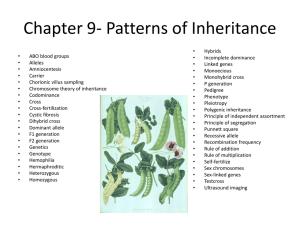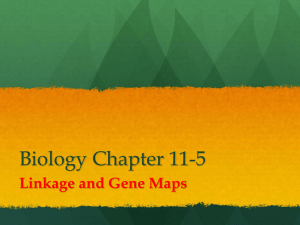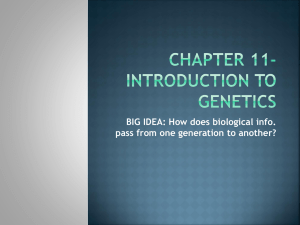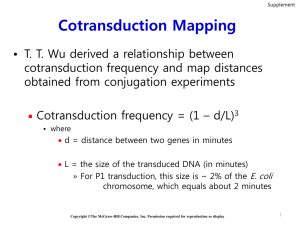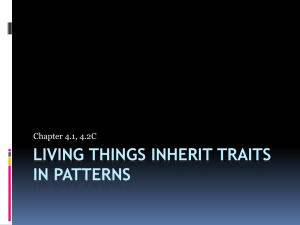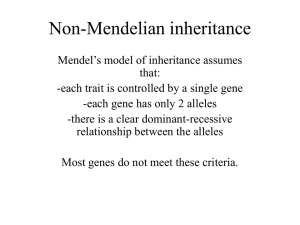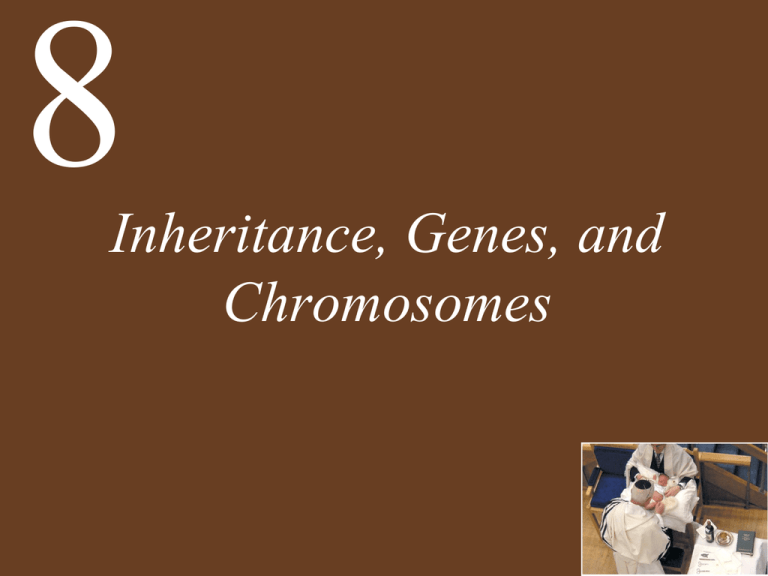
8
Inheritance, Genes, and
Chromosomes
Chapter 8 Inheritance, Genes, and Chromosomes
Key Concepts
• 8.1 Genes Are Particulate and Are
Inherited According to Mendel’s Laws
• 8.2 Alleles and Genes Interact to Produce
Phenotypes
• 8.3 Genes Are Carried on Chromosomes
• 8.4 Prokaryotes Can Exchange Genetic
Material
Chapter 8 Opening Question
How is hemophilia inherited through
the mother, and why is it more
frequent in males?
Concept 8.1 Genes Are Particulate and Are Inherited According to
Mendel’s Laws
Early experiments with genetics yielded two
theories:
• Blending inheritance—gametes contained
determinants (genes) that blended when
gametes fused during fertilization
• Particulate inheritance—each determinant
was physically distinct and remained intact
during fertilization
Concept 8.1 Genes Are Particulate and Are Inherited According to
Mendel’s Laws
Mendel used the scientific method and
studied garden peas.
Their flowers have both male and female
sex organs, pistils, and stamens, to
produce gametes.
Male organs can be removed to allow
fertilization by another flower.
In-Text Art, Ch. 8, p. 145
Concept 8.1 Genes Are Particulate and Are Inherited According to
Mendel’s Laws
Character—observable physical feature
(e.g., flower color, seed shape)
Trait—form of a character (e.g., purple
flowers or white flowers, wrinkled seeds)
Mendel worked with true-breeding
varieties—when plants of the same variety
were crossed, all offspring plants produced
the same seeds and flowers.
Concept 8.1 Genes Are Particulate and Are Inherited According to
Mendel’s Laws
Mendel’s crosses:
Pollen from one parent was transferred to
the stigma of the other parent.
• Parental generation = P
Resulting offspring = first filial generation
or F1
If F1 plants self-pollinate, they produce
second filial generation or F2.
Concept 8.1 Genes Are Particulate and Are Inherited According to
Mendel’s Laws
In Mendel’s first experiment, he crossed
plants differing in just one character (P).
This produced monohybrids in the F1
generation.
The monohybrids were then allowed to selfpollinate to form the F2 generation—a
monohybrid cross.
Mendel repeated this for seven characters.
Figure 8.1 Mendel’s Monohybrid Experiments (Part 1)
Figure 8.1 Mendel’s Monohybrid Experiments (Part 2)
Concept 8.1 Genes Are Particulate and Are Inherited According to
Mendel’s Laws
One trait of each pair disappeared in the F1
generation and reappeared in F2 —these
traits are recessive.
The trait that appears in the F1 is the
dominant trait.
The ratio of dominant traits to recessive
traits in the F2 was about 3:1.
Concept 8.1 Genes Are Particulate and Are Inherited According to
Mendel’s Laws
Mendel’s observations rejected the blending
theory of inheritance and supported the
particulate theory.
He proposed that the determinants occur in
pairs and are segregated in the gametes.
Each plant has two alleles for each
character (gene), one from each parent.
Diploid—two alleles for a gene
Haploid—one allele for a gene
Concept 8.1 Genes Are Particulate and Are Inherited According to
Mendel’s Laws
Alleles are different forms of a gene, such
as smooth or wrinkled seeds.
True-breeding individuals have two copies
of the same allele—they are homozygous
for the allele (e.g., ss).
Heterozygous individuals have two
different alleles (e.g., Ss).
Concept 8.1 Genes Are Particulate and Are Inherited According to
Mendel’s Laws
Phenotype—physical appearance of an
organism (e.g., spherical seeds)
Genotype—the genetic makeup (e.g., Ss)
Spherical seeds can be the result of two
different genotypes—SS or Ss.
Concept 8.1 Genes Are Particulate and Are Inherited According to
Mendel’s Laws
Mendel’s first law:
The law of segregation states that the two
copies of a gene separate when an
individual makes gametes.
Each gamete receives only one copy.
Figure 8.2 Mendel’s Explanation of Inheritance (Part 1)
Concept 8.1 Genes Are Particulate and Are Inherited According to
Mendel’s Laws
When the F1 self-pollinates, there are three
ways to get the dominant trait (e.g.,
spherical), but only one way to get the
recessive (wrinkled)—resulting in the 3:1
ratio.
Allele combinations can be predicted using
a Punnett square.
Figure 8.2 Mendel’s Explanation of Inheritance (Part 2)
Concept 8.1 Genes Are Particulate and Are Inherited According to
Mendel’s Laws
A gene is a short sequence on a longer
DNA molecule.
DNA molecules make up the chromosomes.
Different alleles of a gene segregate when
chromosomes separate during meiosis I.
Figure 8.3 Meiosis Accounts for the Segregation of Alleles (Part 1)
Figure 8.3 Meiosis Accounts for the Segregation of Alleles (Part 2)
Figure 8.3 Meiosis Accounts for the Segregation of Alleles (Part 3)
Concept 8.1 Genes Are Particulate and Are Inherited According to
Mendel’s Laws
Mendel tested his hypothesis by doing test
crosses:
He did this to determine whether an
individual is homozygous or heterozygous
for a trait by crossing it with a homozygous
recessive individual.
Mendel crossed the F1 with known
homozygotes (e.g., wrinkled or ss).
Figure 8.4 Homozygous or Heterozygous? (Part 1)
Figure 8.4 Homozygous or Heterozygous?
Concept 8.1 Genes Are Particulate and Are Inherited According to
Mendel’s Laws
Mendel’s next experiment involved:
Crossing peas that differed in two
characters—seed shape and seed color
True-breeding parents:
SSYY—spherical yellow seeds
ssyy—wrinkled green seeds
Concept 8.1 Genes Are Particulate and Are Inherited According to
Mendel’s Laws
F1 generation is SsYy—all spherical yellow.
Crossing the F1 generation (all identical
double heterozygotes) is a dihybrid
cross.
Mendel asked whether, in the gametes
produced by SsYy, the traits would be
linked, or segregate independently.
Concept 8.1 Genes Are Particulate and Are Inherited According to
Mendel’s Laws
Two possibilities included:
Alleles could maintain associations seen in
parental generation—they could be linked
If linked, gametes would be SY or sy; F2
would have three times more spherical
yellow than wrinkled green.
If independent, gametes could be SY, sy,
Sy, or sY. F2 would have nine different
genotypes; phenotypes would be in 9:3:3:1
ratio.
Concept 8.1 Genes Are Particulate and Are Inherited According to
Mendel’s Laws
Or:
The segregation of S from s could be
independent of Y from y—the two genes
could be unlinked
If independent, gametes could be SY, sy,
Sy, or sY in equal numbers.
The F2 generation would have nine different
genotypes; and four phenotypes in a
9:3:3:1 ratio.
This prediction was supported.
Figure 8.5 Independent Assortment (Part 1)
Figure 8.5 Independent Assortment (Part 2)
Concept 8.1 Genes Are Particulate and Are Inherited According to
Mendel’s Laws
Mendel’s second law:
The law of independent assortment
states that alleles of different genes assort
independently during gamete formation.
This law doesn’t always apply to genes on
the same chromosome, but chromosomes
do segregate independently.
Figure 8.6 Meiosis Accounts for Independent Assortment of Alleles
Concept 8.1 Genes Are Particulate and Are Inherited According to
Mendel’s Laws
One of Mendel’s contributions to genetics
was the use of mathematical analyses—
the rules of statistics and probability.
His analyses revealed patterns that allowed
him to formulate his hypotheses.
Probability calculations and Punnett squares
give the same results.
Concept 8.1 Genes Are Particulate and Are Inherited According to
Mendel’s Laws
Probability
• If an event is certain to happen, probability
=1
• If an event cannot possibly happen,
probability = 0
• All other events have a probability
between 0 and 1
Concept 8.1 Genes Are Particulate and Are Inherited According to
Mendel’s Laws
Two coin tosses are independent events,
each will come up heads ½ the time.
The probability that both will come up heads
is:
½x½=¼
To get the joint probability, multiply the
individual probabilities (multiplication
rule).
Figure 8.7 Using Probability Calculations in Genetics
Concept 8.1 Genes Are Particulate and Are Inherited According to
Mendel’s Laws
Probability in a monohybrid cross
After self-pollination of an F1 Ss, the
probability that the F2 offspring will have
the genotype SS is ½ x ½ = ¼; the same
for ss offspring.
There are two ways to get a heterozygote
Ss; the probability is the sum of the
individual probabilities (addition rule):
¼+¼=½
Concept 8.1 Genes Are Particulate and Are Inherited According to
Mendel’s Laws
Human pedigrees can show Mendel’s laws.
Humans have few offspring; pedigrees do
not show the clear proportions that the pea
plants showed.
Geneticists use pedigrees to determine
whether a rare allele is dominant or
recessive.
Concept 8.1 Genes Are Particulate and Are Inherited According to
Mendel’s Laws
Pattern of inheritance for a rare dominant
allele:
• Every person with the abnormal phenotype
has an affected parent.
• Either all (if homozygous parent) or half (if
heterozygous parent) of offspring in an
affected family are affected.
Figure 8.8 Pedigree Analysis and Inheritance (Part 1)
Concept 8.1 Genes Are Particulate and Are Inherited According to
Mendel’s Laws
Pattern of inheritance for a rare recessive
allele:
• Affected people often have two unaffected
parents.
• In an affected family, one-fourth of children
of unaffected parents are affected.
Figure 8.8 Pedigree Analysis and Inheritance (Part 2)
Concept 8.2 Alleles and Genes Interact to Produce Phenotypes
Different alleles arise through mutation—
rare, stable, inherited changes in the
genetic material.
The wild type is the allele present in most
of the population. Other alleles are mutant
alleles.
A gene with a wild-type allele that is present
less than 99 percent of the time is called
polymorphic.
Concept 8.2 Alleles and Genes Interact to Produce Phenotypes
A given gene may have more than two
alleles.
Multiple alleles increase the number of
possible phenotypes and may show a
hierarchy of dominance in heterozygotes.
One example is the coat color in rabbits.
Figure 8.9 Multiple Alleles for Coat Color in Rabbits
Concept 8.2 Alleles and Genes Interact to Produce Phenotypes
Some alleles are neither dominant nor
recessive.
A heterozygote has an intermediate
phenotype in incomplete dominance.
Red + white snapdragons = pink in F1
Red and white colors reappear in F2 as well
as pink.
Figure 8.10 Incomplete Dominance Follows Mendel’s Laws (Part 1)
Figure 8.10 Incomplete Dominance Follows Mendel’s Laws (Part 2)
Concept 8.2 Alleles and Genes Interact to Produce Phenotypes
Codominance—two alleles of a gene
produce phenotypes that are both present
in the heterozygote.
Example:
• ABO blood group system has three alleles
of the gene: IA, IB, and IO.
Figure 8.11 ABO Blood Reactions Are Important in Transfusions
Concept 8.2 Alleles and Genes Interact to Produce Phenotypes
Epistasis—phenotypic expression of one
gene is influenced by another gene
Example:
• Coat color in Labrador retrievers:
Allele B (black) dominant to b (brown)
Allele E (pigment deposition) is dominant
to e (no pigment deposition—yellow)
Figure 8.12 Genes Interact Epistatically
Copyright © The McGraw-Hill Companies, Inc. Permission required for reproduction or display.
Fig. 13.20(TE Art)
ee
No dark pigment in fur
E_
Dark pigment in fur
Yellow Lab
E_bb
eebb
eeB_
Yellow fur;
Yellow fur;
brown nose, black nose,
lips, eye rims lips, eye rims
E_B_
Chocolate Lab Black Lab
Brown fur,
nose, lips,
eye rims
Black fur,
nose, lips,
eye rims
Fig. 13.20e
Fig. 13.20d
Fig. 13.20c
Fig. 13.20b
Concept 8.2 Alleles and Genes Interact to Produce Phenotypes
Hybrid vigor, or heterosis, is a cross
between two different true-breeding
homozygotes.
It can result in offspring with stronger, larger
phenotypes.
Most complex phenotypes are determined
by multiple genes.
Quantitative traits conferred by multiple
genes are measured, rather than
assessed qualitatively.
In-Text Art, Ch. 8, p. 154
Concept 8.2 Alleles and Genes Interact to Produce Phenotypes
Genotype and environment interact to
determine the phenotype of an organism.
Two parameters describe the effects:
Penetrance is the proportion of individuals
with a certain genotype that show the
phenotype.
Expressivity is the degree to which
genotype is expressed in an individual.
Concept 8.3 Genes Are Carried on Chromosomes
Genes are sequences of DNA that reside at
a particular site on a chromosome—a
locus (plural loci).
The genetic linkage of genes on a single
chromosome can alter their patterns of
inheritance.
Concept 8.3 Genes Are Carried on Chromosomes
Genetic linkage was discovered by Thomas
Hunt Morgan and students at Columbia
University using the fruit fly Drosophila
melanogaster.
Much genetic research has been done with
Drosophila, which is considered a model
organism because of its size, ease of
breeding, and short generation time.
Concept 8.3 Genes Are Carried on Chromosomes
Some crosses performed with Drosophila
did not yield expected ratios according to
the law of independent assortment.
Instead, some genes for body color and
wing shape were inherited together.
Morgan theorized that the two loci were
linked on the same chromosome and
could not assort independently.
Figure 8.13 Some Alleles Do Not Assort Independently (Part 1)
Figure 8.13 Some Alleles Do Not Assort Independently (Part 2)
Concept 8.3 Genes Are Carried on Chromosomes
Some offspring showed recombinant
phenotypes, different from their parents.
Genes may recombine during prophase I of
meiosis by crossing over.
Homologous chromosomes exchange
corresponding segments.
The exchange involves two chromatids of
four in the tetrad—both chromatids
become recombinant (each ends up with
genes from both parents).
Figure 8.14 Crossing Over Results in Genetic Recombination (Part 1)
Figure 8.14 Crossing Over Results in Genetic Recombination (Part 2)
Figure 8.14 Crossing Over Results in Genetic Recombination (Part 3)
Concept 8.3 Genes Are Carried on Chromosomes
Recombinant offspring phenotypes (nonparental) appear in recombinant
frequencies.
To determine the recombinant
frequencies, divide the number of
recombinant offspring by the total number
of offspring.
Recombinant frequencies are greater for
loci that are farther apart on the
chromosome.
Figure 8.15 Recombination Frequencies (Part 1)
Figure 8.15 Recombination Frequencies (Part 2)
Concept 8.3 Genes Are Carried on Chromosomes
Recombinant frequencies can be used to
make genetic maps showing the
arrangement of genes along a
chromosome.
Recombinant frequencies are converted to
map units corresponding to distances
between genes.
In-Text Art, Ch. 8, p. 157 (1)
Concept 8.3 Genes Are Carried on Chromosomes
The fruit fly genome has four pairs of
chromosomes—three pairs are similar in
size, called autosomes.
The fourth pair are of different size, the sex
chromosomes.
Many genes on the X chromosome are not
present on the Y chromosome.
In-Text Art, Ch. 8, p. 157 (2)
Concept 8.3 Genes Are Carried on Chromosomes
Genes on sex chromosomes don’t follow
Mendelian patterns.
The Y chromosome carries few genes; the
X chromosome carries many.
Thus, males have only one copy of these
genes—hemizygous.
Concept 8.3 Genes Are Carried on Chromosomes
Sex-linked inheritance—inheritance of a
gene that is carried on a sex chromosome
One example is the eye color in Drosophila.
Figure 8.16 A Gene for Eye Color Is Carried on the Drosophila X Chromosome (Part 1)
Figure 8.16 A Gene for Eye Color Is Carried on the Drosophila X Chromosome (Part 2)
Concept 8.3 Genes Are Carried on Chromosomes
X-linked recessive phenotypes:
• They appear much more often in males
than females.
• A male with the mutation can only pass it
on to daughters.
• Daughters who receive one X-linked
mutation are heterozygous carriers.
• Mutant phenotype can skip a generation if
it passes from a male to his daughter
(normal) and then to her son.
Figure 8.17 Red–Green Color Blindness Is Carried on the Human X Chromosome
Concept 8.3 Genes Are Carried on Chromosomes
Besides the genes in the nucleus,
mitochondria and plastids contain small
numbers of genes.
Mitochondria and plastids are inherited only
from the mother.
The inheritance of organelles and their
genes is non-Mendelian and is called
maternal or cytoplasmic inheritance.
Figure 8.18 Cytoplasmic Inheritance
Concept 8.4 Prokaryotes Can Exchange Genetic Material
Bacteria exchange genes by bacterial
conjugation.
Sex pilus is a projection that initiates
contact between bacterial cells.
Conjugation tube is a cytoplasmic bridge
that forms between cells.
The donor chromosome fragments and
some material enters the recipient cell.
Figure 8.19 Bacterial Conjugation and Recombination (Part 1)
Figure 8.19 Bacterial Conjugation and Recombination (Part 2)
Concept 8.4 Prokaryotes Can Exchange Genetic Material
Bacteria have plasmids—small circular
DNA molecules—besides the main
chromosome.
Genes on the plasmids are in categories:
• Metabolic tasks, breaking down
hydrocarbons
• Involved in conjugation
• Antibiotic resistance
Concept 8.4 Prokaryotes Can Exchange Genetic Material
Plasmids can move between the cells
during conjugation.
They can:
• Replicate independently of the main
chromosome
• Add their genes to the recipient cell’s
genome
Figure 8.20 Gene Transfer by Plasmids
Answer to Opening Question
In hemophilia, the mutant gene for factor
VIII, the clotting factor, is carried on the X
chromosome.
The affected males inherited their single X
chromosome from their mothers—if the
mutated form of the gene was present,
they would develop the disease.
Daughters would inherit a normal X
chromosome as well and would not
express the recessive trait, though could
be carriers.
Figure 8.21 Sex Linkage in Royal Families of Europe

